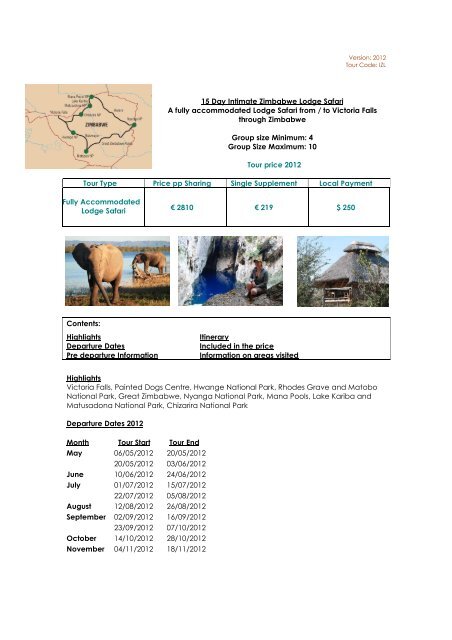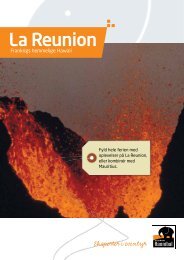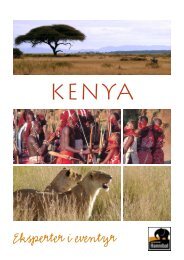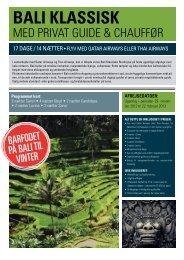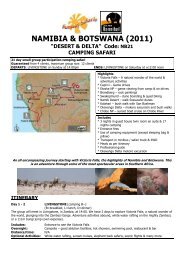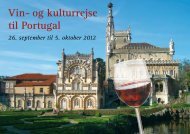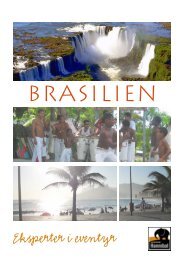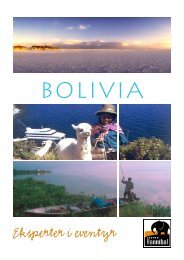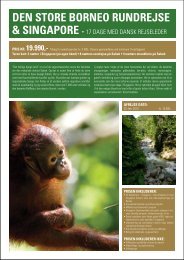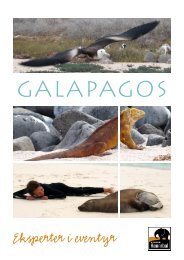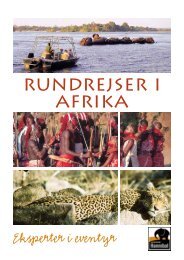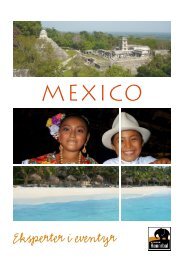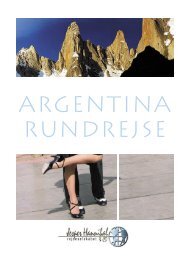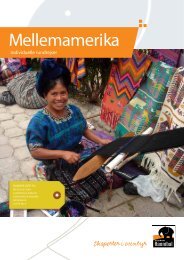15 Day Intimate Zimbabwe Lodge Safari A fully ... - Jesper Hannibal
15 Day Intimate Zimbabwe Lodge Safari A fully ... - Jesper Hannibal
15 Day Intimate Zimbabwe Lodge Safari A fully ... - Jesper Hannibal
Create successful ePaper yourself
Turn your PDF publications into a flip-book with our unique Google optimized e-Paper software.
Version: 2012<br />
Tour Code: IZL<br />
<strong>15</strong> <strong>Day</strong> <strong>Intimate</strong> <strong>Zimbabwe</strong> <strong>Lodge</strong> <strong>Safari</strong><br />
A <strong>fully</strong> accommodated <strong>Lodge</strong> <strong>Safari</strong> from / to Victoria Falls<br />
through <strong>Zimbabwe</strong><br />
Group size Minimum: 4<br />
Group Size Maximum: 10<br />
Tour price 2012<br />
Tour Type Price pp Sharing Single Supplement Local Payment<br />
Fully Accommodated<br />
<strong>Lodge</strong> <strong>Safari</strong><br />
€ 2810 € 219 $ 250<br />
Contents:<br />
Highlights<br />
Departure Dates<br />
Pre departure Information<br />
Itinerary<br />
Included in the price<br />
Information on areas visited<br />
Highlights<br />
Victoria Falls, Painted Dogs Centre, Hwange National Park, Rhodes Grave and Matobo<br />
National Park, Great <strong>Zimbabwe</strong>, Nyanga National Park, Mana Pools, Lake Kariba and<br />
Matusadona National Park, Chizarira National Park<br />
Departure Dates 2012<br />
Month Tour Start Tour End<br />
May 06/05/2012 20/05/2012<br />
20/05/2012 03/06/2012<br />
June 10/06/2012 24/06/2012<br />
July 01/07/2012 <strong>15</strong>/07/2012<br />
22/07/2012 05/08/2012<br />
August 12/08/2012 26/08/2012<br />
September 02/09/2012 16/09/2012<br />
23/09/2012 07/10/2012<br />
October 14/10/2012 28/10/2012<br />
November 04/11/2012 18/11/2012
Version: 2012<br />
Tour Code: IZL<br />
Included in the price<br />
Accommodation as mentioned in the itinerary, all transport in <strong>fully</strong> kitted 4x4 safari<br />
vehicle, game drives as mentioned, meals and activities as mentioned in itinerary, park<br />
entrance fees, experienced local guide.<br />
Not included in the price<br />
Travel insurance, flights, pre and post tour accommodation, optional activities, all drinks,<br />
tips and curios, all personal expenses.<br />
Meal Key<br />
B = Breakfast L = Lunch D = Dinner<br />
Itinerary<br />
<strong>Day</strong> 1: Victoria Falls, <strong>Zimbabwe</strong><br />
On arrival at Victoria Falls Airport in <strong>Zimbabwe</strong> you will be met and transferred to Ilala<br />
<strong>Lodge</strong>. This afternoon we explore the mighty Victoria Falls on a guided tour.<br />
Accommodation:<br />
Ilala <strong>Lodge</strong> or similar (rooms with en-suite bathrooms,<br />
swimming pool, bar & restaurant)<br />
<strong>Day</strong> 2 & 3: Victoria Falls to Hwange National Park, <strong>Zimbabwe</strong><br />
BLD, BLD<br />
After breakfast we depart Victoria Falls and make our way to Hwange National Park. The<br />
afternoon is spent on a game drive with a visit to the Painted Dogs Conservation Centre.<br />
Hwange National Park is one of Africa's finest havens for wildlife and is home to vast<br />
herds of elephant, buffalo, and zebra as well as a very large concentration of giraffe. It is<br />
also home to many predators and endangered species plus very large and varied<br />
birdlife. The whole of the next day is spent exploring this magnificent area.<br />
Distance: 190 km Departure: 08h00<br />
Lunch:<br />
picnic spot en route<br />
Accommodation:<br />
Ivory <strong>Lodge</strong> or similar (Chalets with en-suite bathrooms,<br />
swimming pool & bar area)<br />
<strong>Day</strong> 4: Hwange National Park to Matobo Hills, <strong>Zimbabwe</strong><br />
BLD<br />
We leave the beauty of the Hwange National Park behind us and head to Camp<br />
Amalinda in the Matobo area. Matobo Hills is an area of exquisite beauty, steeped in<br />
tribal history, ancient mystery and dramatic rock landscapes. The national park has<br />
been given UNESCO World Heritage status and is home to both white and black<br />
rhinoceros, sable antelope and the world’s densest population of leopard. Birdlife is<br />
prolific and includes the highest concentration of black eagles in the world. Once the<br />
home of the San (Bushman), this area contains the richest source of the rock art found<br />
anywhere. Not only is it here that the Ndebele people buried their great king, Mzilikazi,<br />
but Cecil John Rhodes was also laid to rest on the “Hill of the Benevolent Spirit” or “Worlds<br />
View” as named by him. We visit the National Park and Rhodes grave.<br />
Distance: 320 km Departure: 08h00<br />
Lunch:<br />
picnic spot en route<br />
Accommodation:<br />
Camp Amalinda or similar (rooms with en-suite<br />
bathrooms, restaurant, bar, & swimming pool)
Version: 2012<br />
Tour Code: IZL<br />
<strong>Day</strong> 5: Matobo Hills to Great <strong>Zimbabwe</strong>, <strong>Zimbabwe</strong><br />
BLD<br />
This morning we drive to the Great <strong>Zimbabwe</strong> Ruins located close to Masvingo.<br />
According to an age-old legend the ruins were built to replicate the palace of the<br />
Queen of Sheba in Jerusalem, and are a unique testimony to the Bantu civilization of the<br />
Shona between the 11th and <strong>15</strong>th centuries. They cover an area of 1800 acres and are<br />
some of the oldest and largest structures located in Southern Africa. We have the<br />
opportunity to explore these ancient ruins, before checking in to our accommodation for<br />
the night, which overlooks Lake Mutirikwe.<br />
Distance: 420 km Departure: 07h00<br />
Lunch:<br />
picnic spot en route<br />
Accommodation:<br />
Norma Jeane’s Lake View Resort or similar (rooms with<br />
en-suite bathrooms, restaurant, bar, & swimming pool)<br />
<strong>Day</strong> 6 & 7: Great <strong>Zimbabwe</strong> to Nyanga National Park, <strong>Zimbabwe</strong><br />
BLD, BLD<br />
Today we head off to the Nyanga National Park and have this afternoon and the<br />
following day to enjoy nature drives in the area. Wildlife to look out for are wildebeest,<br />
kudu, zebra, waterbuck, impala, sable and eland as well as smaller mammals such as<br />
the blue duiker and Samango monkey, neither of which is found outside this area.<br />
Nyanga National Park is situated in one of the most scenic areas of <strong>Zimbabwe</strong>'s Eastern<br />
Highlands. Rolling green hills and perennial rivers transverse the 47 000 hectare park,<br />
which is also home to the country’s highest mountain – Mount Nyangani as well as<br />
Africa’s second highest waterfall, Mtarazi Falls.<br />
Distance: 395 km Departure: 08h00<br />
Lunch:<br />
picnic spot en route<br />
Accommodation:<br />
Pine Tree Inn or similar (rooms with en-suite bathrooms,<br />
restaurant, bar, & swimming pool)<br />
<strong>Day</strong> 8: Nyanga National Park to Bushman Rock, <strong>Zimbabwe</strong><br />
BLD<br />
We travel towards Harare to the Bushman Rock Estate, operational since the mid 1900’s it<br />
is one of the few estate wineries in the country. After we have settled in to our rooms,<br />
high tea is served on the veranda. We take a leisurely guided walk through the<br />
vineyards to the pontoon, for a sundowner cruise. Thereafter we get to sample up to 9 of<br />
the estates private wines on a tutored wine tasting, followed by 3 course dinner.<br />
Distance: 260 km Departure: 08h00<br />
Lunch:<br />
picnic spot en route<br />
Accommodation:<br />
Bushman Rock or similar (rooms with en-suite bathrooms,<br />
swimming pool and tea garden)<br />
<strong>Day</strong> 9 & 10: Bushman Rock to Mana Pools, <strong>Zimbabwe</strong><br />
BLD, BLD<br />
An early wake up call, leads us on a walk to the Bushman Rock, where we explore the<br />
ancient art adorned caves and granite kopjies. After breakfast at the lodge we<br />
continue our journey to one of <strong>Zimbabwe</strong>’s greatest national parks – Mana Pools, where<br />
we have the afternoon and the whole of the next day available to search for African<br />
wildlife in the park on game drives and on canoe excursions. Mana means ‘four’ in<br />
Shona, in reference to the four large permanent pools formed by the meandering<br />
Zambezi River. This World Heritage site has the country's biggest concentration of hippos<br />
and crocodiles as well as large populations of elephant and buffalo.
Version: 2012<br />
Tour Code: IZL<br />
En-route we stop at Chinhoyi Caves for lunch. The caves are composed of limestone<br />
and dolomite and are the most extensive cave system in <strong>Zimbabwe</strong> that is accessible to<br />
tourists.<br />
Distance: 385 km Departure: 07h00<br />
Lunch:<br />
Chinhoyi Caves<br />
Accommodation:<br />
Nyamepi Camp or similar (tents, communal ablutions<br />
with hot water)<br />
<strong>Day</strong> 11 & 12: Mana Pools to Lake Kariba, <strong>Zimbabwe</strong><br />
BLD, BLD<br />
Our journey today brings us to the shores of Lake Kariba. It is one of the world’s largest<br />
man-made lakes and a place of outstanding beauty. At over 220 km long and 30 km at<br />
its widest point it is no wonder it is referred to as an inland sea! The lake is nested in<br />
mountains, guarded by enormous reserves of game and made beautiful and savage by<br />
sun and storm, as well as by earth and water. After lunch a one and a half hour<br />
speedboat trip across the lake we arrive at Rhino Camp, which lies on Elephant Point in<br />
the Matusadona National Park, which is home to the Big 5 and where we spend the next<br />
two nights.<br />
Distance: 170 km Departure: 07h00<br />
Lunch:<br />
picnic spot en route<br />
Accommodation:<br />
Rhino Camp or similar (chalets with en-suite bathrooms,<br />
bar area)<br />
<strong>Day</strong> 13: Lake Kariba to Chizarira National Park<br />
BLD<br />
After breakfast another speedboat takes us to Rukari where we meet our vehicle and<br />
continue to Chizarira National Park. Once we have checked in at Chizarira <strong>Lodge</strong>, we<br />
take a drive through the third largest park in <strong>Zimbabwe</strong>, to see what this true wilderness<br />
has to offer. With 192 000 hectares of untouched flora and fauna, magnificent gorges,<br />
plateaus and flood plains, this pristine park is a spectacular destination for any visitor.<br />
Because of its wild and remote nature, the tranquility and rugged beauty of Chizarira<br />
National Pak is indeed unequalled.<br />
Distance: 180 km Departure: 07h00<br />
Lunch:<br />
a picnic spot en route<br />
Accommodation:<br />
Chizarira <strong>Lodge</strong> or similar (rooms with en-suite bathrooms)<br />
<strong>Day</strong> 14: Chizarira National Park to Victoria Falls, <strong>Zimbabwe</strong><br />
BL<br />
After breakfast we drive back to where our adventure started – Victoria Falls. There will<br />
still be time for optional activities such as boat cruises on the Zambezi River, bungee<br />
jumping and elephant back safaris (all for own expense).<br />
Distance: 340km Departure: 07h00<br />
Lunch:<br />
picnic spot en route<br />
Accommodation:<br />
Ilala <strong>Lodge</strong> or similar (rooms with en-suite bathrooms,<br />
swimming pool, bar & restaurant)
Version: 2012<br />
Tour Code: IZL<br />
<strong>Day</strong> <strong>15</strong>: End of tour<br />
B<br />
Our safari ends after breakfast. You will be transferred to Victoria Falls Airport in time for<br />
your departure flight. We hope to welcome you again one day on another of our<br />
African adventures.<br />
Optional activities in Victoria Falls<br />
Below is a list of some of the most popular optional activities on offer in Victoria Falls.<br />
Pre-booking is recommended to avoid disappointment. The rates are per person and<br />
are quoted in US Dollars. All activities are subject to availability and may require a<br />
minimum amount of passengers to operate. Certain activities only operate at specific<br />
times of the year. Please contact our reservation office for further information.<br />
Should you wish to partake in an activity that is not listed below, we will gladly assist you<br />
with rates and reservations.<br />
13 Minute Helicopter Flight $130.00<br />
25 Minute Helicopter Flight $250.00<br />
Boma Dinner $45.00<br />
Sunset Cruise $45.00<br />
Bungi Jump $132.00<br />
Half <strong>Day</strong> Elephant Back <strong>Safari</strong> $120.00<br />
Elephant Interaction with breakfast or lunch $121.00<br />
Half <strong>Day</strong> Canoeing $110.00<br />
Full <strong>Day</strong> Canoeing $125.00<br />
Half <strong>Day</strong> Rafting $120.00<br />
Full <strong>Day</strong> Rafting $130.00<br />
Flying Fox $38.50<br />
Gorge Swing $88.00<br />
Zip Line $66.00<br />
Half <strong>Day</strong> Lion Walk $130.00<br />
Lion Cub Interaction $65.00<br />
Wildlife Conservation and Awareness <strong>Safari</strong> $75.00<br />
*Please note prices are subject to change<br />
Pre-departure Information<br />
Contents:<br />
Pre and Post Tour Arrangements<br />
Departure Meals Clothing & other items<br />
Transport First Aid Participation<br />
Accommodation Luggage Visas<br />
Spending Money<br />
Insurance<br />
Pre and Post Tour Arrangements<br />
Pre and post tour accommodation and transfers can be arranged on request.<br />
Ilala <strong>Lodge</strong> – standard room (Victoria Falls)<br />
€ 127 per person sharing (BB)<br />
€ 180 per person single (BB)
Version: 2012<br />
Tour Code: IZL<br />
One way airport transfer from Victoria Falls Airport to Victoria Falls Town or vice versa –<br />
€12 per person<br />
Should you require alternative accommodation or transfers to different points, please<br />
contact our reservation office, who will gladly assist you.<br />
Departure:<br />
The <strong>Intimate</strong> <strong>Zimbabwe</strong> <strong>Safari</strong> starts in Victoria Falls. Your arrival airport transfer is<br />
included in this package. The departure time on <strong>Day</strong> 2 will be at 08h00.<br />
Please note that the daily departure times are a guideline only and are subject to<br />
change due to seasonal variations, as well as unforeseen circumstances. The final<br />
decision rests with your guide who will advise you at what time you will be departing<br />
each day.<br />
Transport:<br />
Jenman <strong>Safari</strong>s uses <strong>fully</strong> equipped Toyota Landcruiser or other appropriate vehicles with<br />
comfortable seating, windows for game viewing and a music system. All luggage is<br />
carried on the roof racks to ensure maximum comfort in the vehicle.<br />
Accommodation:<br />
On 12 nights of this safari, you will be accommodated in typical mid-range African lodge<br />
establishments, situated either in the National Parks, on the banks of a river, or other<br />
place of interest. <strong>Lodge</strong> <strong>Safari</strong>s offer accommodation with a mix of lodges, chalets and<br />
tented camps. All of them have a private bathroom with a shower or bath and a toilet.<br />
Some properties are equipped with swimming pools and/or bar areas.<br />
The remaining two nights of this safari will be in a basic tented camp with communal<br />
ablution facilities.<br />
Spending money:<br />
Clients are advised to bring enough money to cover the purchase of curios, tips,<br />
alcoholic drinks and additional entertainment. US Dollars and South African Rands are<br />
the most practical and convenient currencies.<br />
Meals:<br />
Breakfasts and dinners will be enjoyed in the restaurants of the various accommodation<br />
establishments, but on certain nights the guide will provide an authentic meal for the<br />
group. Lunch will be arranged by the guide on driving days and excursions. Please<br />
advise us of any special dietary requirements in advance.<br />
First Aid:<br />
Our guides are trained in basic first aid and the vehicle is equipped with a<br />
comprehensive medical aid kit. Preventative Malaria medication should be taken<br />
before the trip and throughout its duration. It is advisable to consult a doctor prior to<br />
departure.<br />
Luggage:<br />
Maximum baggage allowance: 12 kg. Jenman <strong>Safari</strong>s stipulates this luggage allowance,<br />
as an overloaded vehicle is a danger to both the clients and the guide. This does not<br />
include photographic equipment and a small daypack. Please bring a backpack or soft<br />
barrel bag, not a suitcase.
Version: 2012<br />
Tour Code: IZL<br />
Don't bring too much clothing, as there are washing opportunities along the way. Please<br />
adhere to the allowance specified as space for luggage is limited.<br />
Insurance:<br />
It is compulsory for all travellers to have insurance covering their personal requirements,<br />
medical expenses and personal possessions. This is to be arranged before leaving your<br />
home country. Jenman <strong>Safari</strong>s has comprehensive public liability insurance.<br />
Clothing and other items:<br />
shorts camera walking shoes<br />
light trousers/jeans swimming costume sandals<br />
T-shirts sun hat windbreaker<br />
warm clothes (May – August) long-sleeved shirts towel<br />
torch & spare batteries water bottle mosquito protection<br />
UV protection<br />
Participation:<br />
This is a non-participation safari.<br />
Visas:<br />
The onus is on the client to organize all visas required to visit <strong>Zimbabwe</strong> prior to departure.<br />
Local Payment:<br />
On most of our safaris a local payment needs to be paid to the guide before the tours<br />
starts. Your local payment covers on-the-road expenses, such as national park entrance<br />
fees, excursions and activities, as well as the use of local guides. This provides your guide<br />
with sufficient funds on the road and ensures that your money goes directly to the<br />
African communities.<br />
Information on areas visited<br />
Contents:<br />
<strong>Zimbabwe</strong> Victoria Falls Hwange National Park<br />
Matobo Great <strong>Zimbabwe</strong> Nyanga National Park<br />
Mana Pools Lake Kariba Chizarira National Park<br />
ZIMBABWE<br />
This is a country blessed with great natural beauty, game reserves and mineral wealth.<br />
The diverse landscape changes from mountainous to wilderness to typical Bushveld. The<br />
country is also home to large animals and a large bird population. <strong>Zimbabwe</strong> is a country<br />
located in the southern part of the continent of Africa, between the Victoria Falls,<br />
Zambezi River, Kariba Dam and the Limpopo river. <strong>Zimbabwe</strong> is bordered by South Africa<br />
to the south, Botswana to the west, Zambia to the north and Mozambique to the east.<br />
Victoria Falls<br />
‘So lovely it must have been gazed upon by angels in their flight’ said David Livingstone<br />
of the supreme Mosi-oa-Tunya (‘The smoke that thunders’). This legendary traveler first<br />
saw the Falls from the Zambian side and his memory is enshrined in the nearby town of<br />
Livingstone. The views from the <strong>Zimbabwe</strong>an & Zambian side are quite different, varying<br />
dramatically depending on the season and water flow.
Version: 2012<br />
Tour Code: IZL<br />
The Falls are over a mile in length and boast the largest curtain of water in the world -<br />
over 500 million litres of water per minute cascade over the falls and drop 100 m at<br />
Rainbow Falls on the Zambian side. Not surprisingly is it the seventh natural wonder of the<br />
world and fast becoming one of the top adventure destinations in the world.<br />
The river is divided into a series of braided channels that descend in many separate falls.<br />
Below the Falls the river enters a narrow series of gorges, which represent locations<br />
successively occupied by the falls earlier in their history. Since the uplifting of the<br />
Makgadikgadi Pan area some two million years ago, the Zambezi River has been cutting<br />
through the basalt base rock, exploiting weak fissures, and forming a series of retreating<br />
gorges. Seven previous waterfalls occupied the seven gorges below the present falls,<br />
and Devil's Cataract in <strong>Zimbabwe</strong> is where the next cut back will form a new waterfall<br />
that will eventually leave the present falls lip high above the river in the gorge below.<br />
Hwange National Park<br />
Hwange National Park is one of Africa's finest havens for wildlife and is home to vast<br />
herds of elephant, buffalo, and zebra and has a very large concentration of giraffe. It is<br />
also home to many predators and endangered species plus very large and varied<br />
birdlife.<br />
The park is situated on the main road between Bulawayo and the world famous Victoria<br />
Falls. Hwange National Park covers just over 14 600 square kilometres. The Park carries<br />
105 mammal species, including 19 large herbivores and eight large carnivores. Elephant<br />
make up the largest proportion of the biomass. All <strong>Zimbabwe</strong>'s specially protected<br />
animals are to be found in Hwange and it is the only protected area where gemsbok<br />
and brown hyena occur in reasonable numbers. The population of wild dog to be found<br />
in Hwange is thought to be of one of the largest surviving groups in Africa today.<br />
The landscape includes desert sand to sparse woodland as well as grasslands and<br />
granite outcrops. Due to the lack of water, man-made waterholes were introduced to<br />
sustain the animals through the dry season. The park has an interesting variety of<br />
landscapes with one part running alongside the North-eastern end of the Kalahari<br />
Desert. The south is sandy with extensive forests and open grassland. A feature of the<br />
area is ancient fossil dunes - ancient sand dunes held together by vegetation.<br />
Matobo<br />
The Matobo National Park forms the core of the Matobo or Matobo Hills, an area of<br />
granite kopjes and wooded valleys commencing some 35 kilometres south of Bulawayo,<br />
southern <strong>Zimbabwe</strong>. The Hills were formed over 2000 million years ago with granite being<br />
forced to the surface, this has eroded to produce smooth "whaleback dwalas" and<br />
broken kopjes, strewn with boulders and interspersed with thickets of vegetation. Mzilikazi,<br />
founder of the Ndebele nation, gave the area its name, meaning 'Bald Heads'.<br />
The Hills cover an area of about 3100 km², of which 424 km² is National Park, the<br />
remainder being largely communal land and a small proportion of commercial<br />
farmland. The park covers some beautiful scenery including some spectacular balancing<br />
rocks and impressive views along the Thuli, Mtshelele, Maleme and Mpopoma river<br />
valleys. Part of the national park is set aside as a 100 km² game park, which has been<br />
stocked with game including black and white rhinoceros. The highest point in the hills is<br />
the promontory named Gulati (<strong>15</strong>49 m) just outside the north-eastern corner of the park.
Version: 2012<br />
Tour Code: IZL<br />
Great <strong>Zimbabwe</strong><br />
Construction starting in the 11th century and continuing for over 300 years, the ruins at<br />
Great <strong>Zimbabwe</strong> are some of the oldest and largest structures located in Southern<br />
Africa. At its peak, estimates are that the ruins of Great <strong>Zimbabwe</strong> had as many as 18,000<br />
inhabitants. The ruins that survive are built entirely of stone. The ruins span 1,800 acres<br />
(7 km²) and cover a radius of 100 to 200 miles (160 to 320 km).<br />
The ruins can be broken down into three distinct architectural groups. They are known as<br />
the Hill Complex, the Valley Complex and the famous Great Enclosure. The Hill Complex<br />
was used as a temple, the Valley complex was for the citizens, and the Great Enclosure<br />
was used by the king. Over 300 structures have been found so far in the Great Enclosure.<br />
The type of stone structures found on the site gives an indication of the status of the<br />
citizenry. Structures that were more elaborate were probably built for the kings and<br />
situated further away from the center of the city. It is thought that this was done in order<br />
to escape sleeping sickness.<br />
What little evidence exists suggests that Great <strong>Zimbabwe</strong> also became a center for<br />
trading, with artifacts suggesting that the city formed part of a trade network extending<br />
as far as China. Chinese pottery shards, coins from Arabia, glass beads and other nonlocal<br />
items have been excavated at <strong>Zimbabwe</strong>.<br />
Nobody knows for sure why the site was eventually abandoned. Perhaps it was due to<br />
drought, perhaps due to disease or it simply could be that the decline in the gold trade<br />
forced the people who inhabited Great <strong>Zimbabwe</strong> to look for greener pastures.<br />
Nyanga National Park<br />
Nyanga (formerly known as Inyanga) is a town in the province of Manicaland,<br />
<strong>Zimbabwe</strong>, located adjacent to Nyanga National Park in the Eastern Highlands about<br />
105 km north of Mutare. According to the 1982 Population Census, the town had a<br />
population of 2,973. The highest mountain in <strong>Zimbabwe</strong>, Mount Nyangani lies about <strong>15</strong><br />
km from the village. Its highest peak rises to 2,600 m above sea level. Nyanga is a popular<br />
tourist destination with its trout fishing, golf courses, mountain hikes and holiday resorts.<br />
Nyanga also accommodates the highest waterfalls in the country - the Mtarazi Falls are<br />
about 760 m high. The surrounding areas also contain many Stone Age and Iron Age<br />
archaeological remains such as pit structures, stone forts, terraces and pathways.<br />
In the town is the bustling township of Nyamhuka, around which there is an ever<br />
expanding growth of high and medium density housing.<br />
The Nyanga Area has long been regarded as a place of great natural beauty. In 1896,<br />
Cecil John Rhodes wrote to his agent: "Dear McDonald, Inyanga is much finer than you<br />
described...Before it is all gone, buy me quickly up to 100 000 acres [400 km²], and be<br />
sure to take in the Pungwe Falls. I would like to try sheep and apple growing."<br />
Mana Pools<br />
Mana Pools is a wildlife conservation area in Northern <strong>Zimbabwe</strong> constituting a National<br />
Park. It is a region of the lower Zambezi River in <strong>Zimbabwe</strong> where the flood plain turns into<br />
a broad expanse of lakes after each rainy season. As the lakes gradually dry up and<br />
recede, the region attracts many large animals in search of water, making it one of<br />
Africa's most renowned game-viewing regions.<br />
Mana means ‘four’ in Shona, in reference to the four large permanent pools formed by<br />
the meanderings of the middle Zambezi. These 2,500 square kilometres of river frontage,<br />
islands, sandbanks and pools, flanked by forests of mahogany, wild figs, ebonies and<br />
baobabs, is one of the least developed National Parks in Southern Africa. It was saved<br />
from a hydro-electric scheme in the early eighties which would have seen the flooding of<br />
this subsequent World Heritage site.
Version: 2012<br />
Tour Code: IZL<br />
It has the country’s biggest concentration of hippopotamuses and crocodiles and large<br />
dry season mammal populations of elephant and buffalo.<br />
Lake Kariba<br />
Having cascaded over the Victoria Falls, and tumbled and swirled through the Batoka<br />
gorges, the old Zambezi River then flowed gently across a flat valley floor to the Kariba<br />
gorge. This was the home of the BaTonka people who believed there was a god of the<br />
river – Nyaminyami. Enter technological man and his desire to put a dam wall across the<br />
Kariba gorge to harness the river’s flow to generate hydroelectric power. The dream<br />
became a fact in December 1958, and the man-made Lake Kariba began to fill, and<br />
reached its capacity four years later. In the meantime, about 57 000 tribes people had to<br />
be resettled, and “Operation Noah” led by Rupert Fothergill, had rescued and<br />
translocated 5000 animals.<br />
Kariba dam wall has a height of 128 m and produces a lake of 5200 km² in area at full<br />
capacity. Then the water surface is at an altitude of 484 m above sea level. On the<br />
<strong>Zimbabwe</strong>an side, the water became the Lake Kariba Recreational Park, with an area of<br />
2830 km². During its life so far, the lake has had its share of ecological incidents, and three<br />
should be mentioned. In its early eutrophic days, the lake witnessed an invasion of a<br />
water fern (Salvinia molesta), named the Kariba weed, but over the ensuing years the<br />
weed has greatly declined. In the 1960s several introductions of the Lake Tanganyika<br />
sardine (Limnothrissa miodon) were made, and eventually the ‘kapenta’ fishery has<br />
developed to great productivity. Finally, being a ‘sink’, the lake has accumulated<br />
pesticides and pollution from agriculture and tsetse fly control in its catchment.<br />
Fortunately, surveys have shown that the early dire predictions, for example, of Fish<br />
Eagles going extinct, have not been realised.<br />
Kariba town is one of the hottest places in <strong>Zimbabwe</strong>, with temperatures sometimes<br />
exceeding 40ºC. The average rainfall along the lake is 650-700 mm, occurring mainly in<br />
November to March. The main habitats are mopane woodland and grassland in the<br />
shore, with shelving or rocky slopes. There are many islands (previously hill-tops) in the<br />
lake. The Zambezi water is rather clean and poor in nutrients, having filtered through<br />
Barotseland in Zambia, which puts a severe limit on the numbers of water birds that can<br />
be accommodated. Nevertheless along the shore one seems never to be out of earshot<br />
of a vociferous Fish Eagle, and this bird can surely serve as the emblem for the lake.<br />
Chizarira National Park<br />
Chizarira is perhaps the most scenic park in <strong>Zimbabwe</strong>. The remoteness of the area is<br />
aptly captured by the name “Chizarira”, which is a Shona word meaning “cage trap”.<br />
Closed off by name and nature, Chizarira's high escarpment views, green gorges, natural<br />
springs, dense woodlands and floodplains are remote and infrequently visited. Most of<br />
the Park is an undulating plateau set on the Zambezi Escarpment overlooking Lake<br />
Kariba. From here the Park extends southwards to the low-lying Busi region. The banks of<br />
the Busi River strongly resemble the river frontage of Mana Pools National Park. Acacia<br />
Albida trees attract many herbivores, in particular elephants, to the riverbank.<br />
This used to be big five country, but the black rhino were relocated in order to protect<br />
and monitor their diminishing numbers. Good populations of elephant, buffalo, lion and<br />
leopard can still be found in the Park. Other game includes cheetah, zebra and a range<br />
of antelope including sable, common waterbuck, kudu, bushbuck, klipspringer and<br />
steenbok. With its grassy valleys and riverine forests Chizarira is also a birders paradise.<br />
The game is widely distributed throughout the Park and viewing can be difficult due to<br />
the tall grass. The appeal of Chizarira lies instead in its total remoteness and the<br />
opportunity to experience Africa in its original form.
Version: 2012<br />
Tour Code: IZL<br />
The Park is known for its excellent game walking and the best way to enjoy the flora and<br />
fauna is to walk along the elephant tracks and mountain trails with a professional guide.<br />
Although it is open year round, the rainy season renders some areas inaccessible, and<br />
the best time to visit is June to September.


